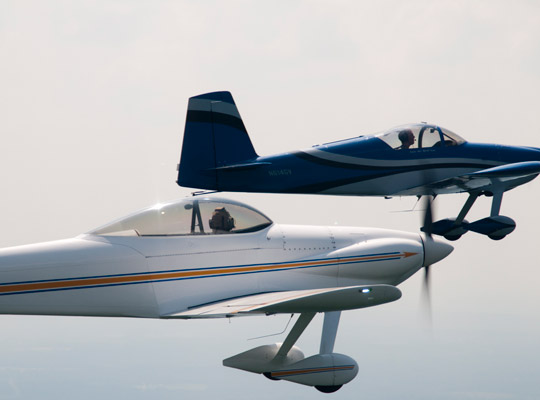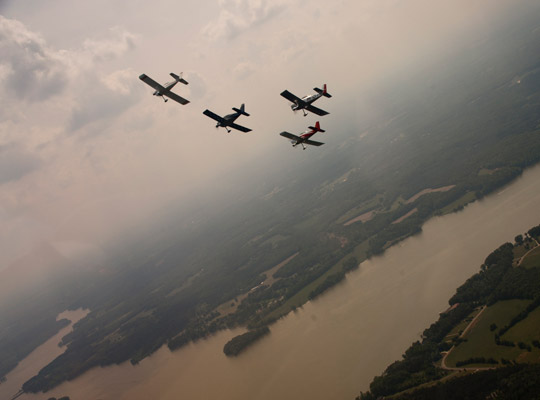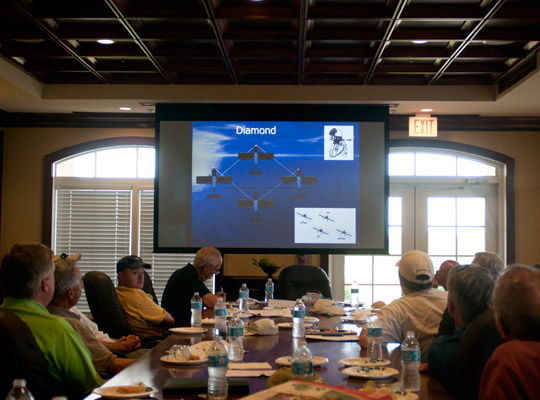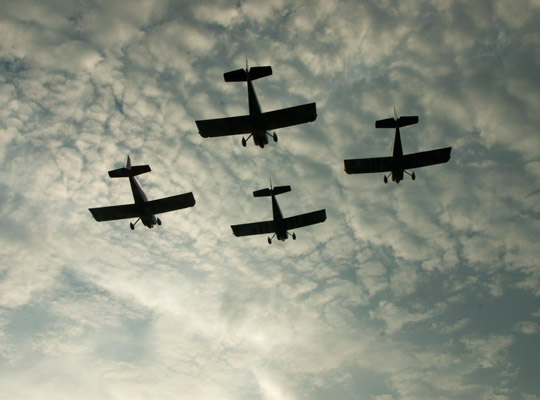“Wiggle your toes, number two,” Mike “Kahuna” Stewart, a Formation Flying Inc. (FFI) check pilot and leader of Team AeroDynamix, tells me over the radio. Kahuna is evaluating us from his RV-8 about 100 feet in trail. “Relax. You’ll fly better if you aren’t so tense.”
He’s right, of course, but I’m feeling the pressure.
For civilian-trained general aviation pilots like me, formation flying goes against our most deeply ingrained habits. Instead of staying away from other airplanes in flight, we must get close to them. Instead being in command of every aspect about the way our flying is conducted, we hand over critical responsibilities to others.
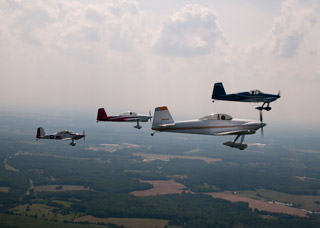
The mental shift is profound, and essential.
Whenever my mind starts to wander or my eyes stray from the two objects I’m trying to align, I drift ever so slightly out of position—and each transgression is duly noted and makes things harder for the pilots I’m flying with. We’re less than half-way through an hourlong checkride, and the most demanding aspects are still to come.
Lost art
After the Cold War as the U.S. military trained fewer and fewer pilots, it seemed a natural and irreversible consequence that formation flying would become a lost art.
The military had spent nearly a century perfecting a demanding skill with few practical applications outside of tactical war fighting. But a strange thing happened to formation flying on its way to irrelevance.
Stu McCurdy, a former Air Force pilot and RV-8 builder in Texas, developed a training curriculum and got the FAA to approve a new organization called Formation Flying Inc. And the rapid growth of the Van’s Aircraft RV series of kit airplanes created a critical mass (more than 8,200 and counting) of airplanes that are especially well suited for formation flying. (An ideal owner-flown formation airplane has a low wing, bubble canopy, control stick, non-vernier throttle, normally aspirated engine that can tolerate rapid power adjustments, and relatively low operating costs.)
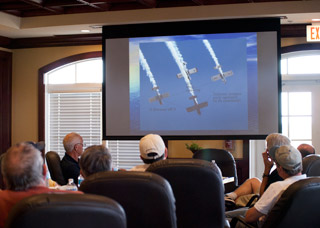
FFI has organized mass formations such as a 40-RV flyover at EAA AirVenture 2012, and a Kansas City-based FFI group has put together similar flights at major sporting events. Other formation organizations such as Formation and Safety Team (FAST) and Training Squadron One (TRARON) are long established among warbird pilots, and Beechcraft and Cessna owners have popularized civilian formation flying with mass arrivals at airshows and other events.
Civilian formation flying groups such as the Lima Lima Flight Team, Trojan Horsemen, Collaborators, and Black Diamonds are airshow staples. Team AeroDynamics flies both day and night routines with a dozen RVs—most of them built by the pilots who fly them.
Each organization sponsors at least one annual formation clinic in which members standardize methods, practice skills, introduce new pilots to the demanding discipline, and offer checkrides for those wishing to get wing- or lead-pilot endorsements.
FFI limits attendance at its clinics to 50 pilots and airplanes, and 45 attended the organization’s three-day event at Stanly County Airport in Albemarle, N.C., in May. About one-third of the pilots there were attending their first formation clinic, and new pilots are the focus of each gathering.
“If it’s the same people every time, it’s just a get-together,” said Jerry “Widget” Morris, a former Air Force and retired airline pilot who flies with Team AeroDynamix and teaches the FFI ground school. “The new guys are the reason we’re here.”
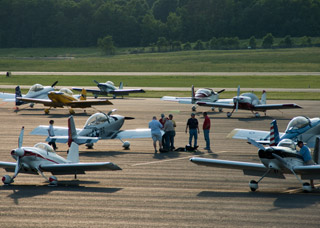
Widget’s welcoming attitude is an FFI custom—but so is brutal honesty. The flying standards are high, and there is no room for compromise. Hyper-achieving pilots accustomed to collecting accolades and advanced ratings get a steady diet of humble pie.
A pilot attending his second clinic asks flight leader Ron “Smokey” Schreck to clear him to take a wing checkride, and Smokey bluntly declines.
“You need more experience first,” says Smokey, a former Air Force fighter pilot and Team AeroDynamix member. “Don’t be in a hurry. Fly as much as you can this weekend, and keep practicing when you get home. You’ve got a great group of pilots to fly with, and they’ll teach you a lot. Come back next year and show us what you’ve learned.”
Post-flight briefings are painfully candid and sometimes take up to an hour.
First, the lead pilot gives a warts-and-all assessment of the entire flight from engine start to shutdown. Next, the pilot flying the No. 2 position shares his impressions, and so on for every participant. Flaws are scrutinized and there’s no allowance for fragile egos. Participants are graded on every task beginning with the radio check-in, and their progress—or a lack of it—is carefully noted.
Each attendee has a color code, and flights are arranged so that new pilots get most opportunities to learn from more experienced formation fliers.
A pilot new to formation flying is given a red code designating his status as “scary,” and he must have an instructor in his aircraft to be part of any formation. The next level is pink meaning a pilot has some formation training and can fly solo in two-ship formations only. Yellow indicates pilots are safe to participate in four-ship formations. Green shows pilots have passed a wing checkride, and blue designates flight leaders.

A scheduler arranges four formation flights a day for each pilot, and flights can be comprised of two, three, and sometimes four colors.
Claustrophobic
The most claustrophobic formation maneuvers are echelon turns and close trail, and this checkride includes generous amounts of both.
During echelon turns, the lead airplane turns away and the challenge is to stay tight while aligning the lead airplane’s spinner with the horizon. Doing so properly requires each pilot to place his canopy close enough to the belly of the airplane ahead that he can see minute trails of engine oil trickling over individual rivets.
Close trail means dropping back about 15 feet and aligning the lead airplane’s tailwheel with the back of the pilot’s head—then keeping it there through a series of climbing and descending turns. Knowing two more airplanes are sharing the same close-up view of my tailpipe provides a strong incentive to stay in position.
The lead pilot can’t see me tucked in behind him, but Kahuna can.
“Move forward two feet,” he tells me. “Burn that sight picture into your mind.”
The least intuitive and most troublesome part of most formation checkrides is the rejoin. With each airplane in loose trail with a little more than 1,000 feet separation, our formation stretches out nearly one mile. Lead wags his wings and begins a turn, and the rest of us close ranks as quickly as we can. We perform the rejoins in both right and left turns, and somewhat surprisingly, they go well. We’re all back in place within about 60 seconds.

The last item on the checkride is a formation landing on 100-foot-wide runway Runway 26 Left—and I’m to touch down precisely abreast of the lead airplane. Fortunately, the wind is calm and Neon—who is taking his lead checkride—flies an arrow straight final approach to a smooth touchdown and we roll to a stop together. As we exit the runway, I exhale for what seems like the first time all day. I’m shiny with sweat and my throttle hand is knotted from constant power adjustments. When I glance over at Neon, he’s smiling.
The post-flight debriefing is mercifully devoid of fireworks. Kahuna hands out mostly compliments, and he informs Neon that he has passed his lead pilot checkride. My color code shifts to green.
The FFI card only means that those who hold it can fly in “waivered airspace” at airshows, something that I have no immediate plans to do. But the growing number of cards issued is proof that formation flying, a particularly dynamic and hard-won discipline, is thriving among GA pilots who value the teamwork, skill, and camaraderie that goes into it.
The pairings for the next series of flights are announced—and instead of my customary wing position, this time I’ll lead a four-ship flight. Two of the pilots in my group are highly experienced but one is red and Bud “Joker” Newhouse, a veteran FFI leader, will fly with him in the No. 2 position.
The takeoff and initial join-up go well. But the quick and jerky motions of the No. 2 aircraft reveal the pilot’s nervousness—as I can well relate.
“Hey number two,” I tell him. “Wiggle your toes.”
Formation flying by the regs
Pilots who fly formation must adhere to the FAA regulations. 14 CFR 91.111 specifically addresses formation flying.
“14 CFR 91.111 Operating near other aircraft.
(a) No person may operate an aircraft so close to another aircraft as to create a collision hazard.
(b) No person may operate an aircraft in formation flight except by arrangement with the pilot in command of each aircraft in the formation.
(c) No person may operate an aircraft, carrying passengers for hire, in formation flight.”
I’m concentrating so intently during this formation checkride that my whole world is reduced to lining up two small and seemingly trivial objects: the lead airplane’s aileron hinge and spinner.
As long as those items stay aligned, my airplane is in the proper position and I’m upholding my part of the “formation contract”: Namely, staying in the right place while the lead pilot handles the navigation, communication, traffic, and airspace for all four airplanes.
Two other pilots are doing the same thing on the opposite side of the lead airplane, a sky blue Vans RV-7 built and flown by Greg “Neon” Vouga, but I’m trying to pretend they don’t exist. We’re flying over the lush green hills of North Carolina’s central and piedmont regions on a gorgeous spring afternoon, but I’m blocking out the scenery, too.
As Neon winds through a series of climbs, descents, and serpentine turns that regularly reach 30 degrees of pitch and 60 degrees of bank, I’m focused on aileron hinge and spinner and trying to will them into place as our four airplanes move as one.

